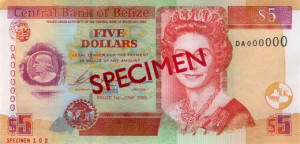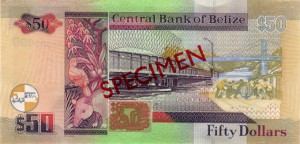Belize’s unit of currency is the Belize Dollar. The basic rate for a US dollar to Belize dollar exchange is set at 2 Belize dollars to 1 US dollar. However, banks may provide a slightly lower rate to include a commission on the exchange.
When visiting Belize, there’s really no need to convert your money from US dollars since the US currency is widely accepted all across the country at a 2 to 1 exchange rate in most shops and restaurants.
However if you do decide to exchange your US dollars for Belize dollars, be aware that Belize dollars isn’t as universally accepted like the US dollar. It is only used within Belize. Should you visit neighboring Mexico or Guatemala, you can exchange Belize dollars for pesos or quetzal. If you’re returning to the US, UK, Canada or Europe, the commercial banks normally convert Belize dollars to all these currencies.
Declaration of Funds Upon Entry to Belize
The Belize law requires every traveler entering Belize to declare any funds they bring with them that is over US $5000 on their disembarkation card upon presentation to the Belize Customs Authority. This US $5000 limit is per travelling adult and is in the form of cash or cheques. Should the excess not be declared, the traveler may be fined up to three times the undeclared amount.
The Belize Currency
The Belize currency is printed at De La Rue Ltd., a British company. As a member of the British Commonwealth, Belize has the Queen of England as its head of state. As such, all local bank notes feature a prominent image of Queen Elizabeth II on the front.
By law, Belizeans are not permitted to hold US currency bank accounts. In order to acquire US dollars for travel, imports or any other expenses, Belizeans must apply for the funds via a permit submitted to the Central Bank of Belize. US dollars are sold in Belize at a rate of 1 USD to 2.0175 BZD. USD is bought at a rate of 1.98 USD = 2 BZD.
The law that prohibit Belizeans from holding a US currency account does not apply to Belize passport holders who do not reside in Belize. However, any money in excess of US $5,000 that is brought into the country must be declared.
Those coming to Belize from Mexico or Guatemala cannot visit commercial banks to get local currency. They have convert their local currencies to Belize dollars with money changers at their respective borders. The commercial banks in Belize only convert local Belize dollars to USD, CAD, GBP and EURO physical currencies, and vice versa.
Security Features of the Belize Currency
When handling any currency, it is very important to be aware of how to spot counterfeits in order to avoid participating in any illegal transactions. In Belize there are 8 security features for each bank note:
- Watermark – Belize has 3 different versions of currency in circulation, the 1990, 1998 and 2003 version. The 1990 issue has the “Sleeping Giant” watermark on all notes. The 2003 and 1998 versions have a Jaguar watermark on the $100 and $50 notes and the Sleeping Giant remains on the $20, $10, $5 and $2 notes. The 2003 version bank notes also have the value of each denomination in letters as an electrotype below the watermark.
- Windowed Thread – There is a security thread incorporated in the bank note when it is manufactured. This thread is visible when held up to the light. The 2003 bank notes has a widened thread of 1.5 mm. The thread glows blue and reads “BELIZE” followed by an inverted “BELIZE” under UV light. The 1998 bank notes’ security thread will read “Belize” followed by the notes’ denomination under UV light for the $20, $50 and $100 notes. The 1990 notes thread illuminates under UV light.
- See-through Feature – Each denomination has a different design for the see-through feature, but all can be found at the same location below the water mark. To verify the note’s authentication, hold it up to the light and the printed design of the back will fit exactly within the unprinted areas of the front of the note.
- Novel Numbering – This novel numbering appears in black on the right hand side on the front of the 2003 and 1998 bank note versions. The novel numbering shows progressively larger digits in adjacent positions.
- Printed Metallic Feature – This feature appears in the lower left hand corner on the front of the $100 and $50 notes. It is printed in metallic ink and shows the numeric value of the note along with the initials “CBB” when the note is viewed from different angles.
- Applied Metallic Feature – This applied metallic feature appears on the $100 and $50 notes. The $100 note has a hologram located on the right of the 2003 and 1998 issues that carries small images of the toucan and the numeral 100 within it. The 2003 version of the $100 note also has an intaglio overprint in the shape of a periwinkle flower as added security. The $50 note has a highly reflective metallic foil in the shape of an angel fish with a jade head printed over it in intaglio.
- Intaglio – Intaglio printing gives the bank notes their unique feel by depositing a layer of ink of varying thickness on the paper while simultaneously embossing the paper surface.
- UV Feature – This UV feature is printed on the surface of the notes and is only visible under UV light. The bank notes show two blocks of invisible ink with the numeral of the denomination and the jabiru stork on the front. The back of the note shows one block with the numeral of the denomination.
Below are specimens of the Belize bank notes provided by the Central Bank of Belize on their website.













